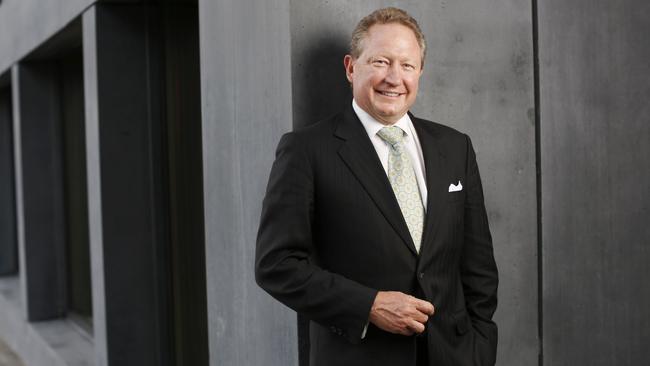
From AGL’s perspective it’s back to the future, reinvesting $314m as its share of a consortium bid for Tilt Renewables a matter of weeks after it took $1.9bn in writedowns on dud contracts from its last wind power ventures.
AGL’s Brett Redman is a couple of weeks away from unveiling a potential split in his company, with a renewables portfolio attached to his 4.2 million customer base in one entity and the coal-powered generation fleet in another.
The PowAR consortium acquisition is also part of the consolidation of the renewables sector as big energy and others snap up the smaller pure-play operators.
Fortescue Metals chair Andrew Forrest has his foot firmly on the accelerator, creating a green hydrogen industry and mulling a move into his own green steel venture.
This comes as he fast-forwards his commitment to carbon-neutrality, bringing the company’s target forward 10 years to 2030.
BHP and Rio might be talking up their role in Scope 3 emissions but Forrest declared on Monday that “we need to provide a carbon- free alternative — steel markets have never had abundant supplies of alternatives”.
He has a range of revolutionary tests to be completed mid-year, including green ammonia-powered ships, large battery technology on work trucks, green ammonia-powered trains and converting iron ore to steel at low temperatures without coal.
His aim is to eliminate fossil fuels from the supply chain, which is a noble aim, without peer on a substantial scale, and if it works he will have filled the gaps in the climate change debate.
Plenty doubted Forrest would become the third force in iron ore, and while there are the usual myriad points of attack, noone is going to doubt his ability to achieve his stated goals this time around.

By contrast to Forrest’s plans to start in 2023, a rival hydrogen venture — the CWP Global-owned Asian renewable hub in the Pilbara — is aiming for a 2025 final investment decision for its mega project.
The $2.7bn takeover of Tilt Renewables has left the Australian stockmarket bereft of listed renewable companies at a time when the industry is all the rage.
A combination of PowAR and New Zealand’s Mercury have acquired the 65 per cent Infratil-controlled vehicle.
Last year Spanish giant Iberdrola acquired Infigen, and a smaller player, New Energy Solar, sold its Australian assets to concentrate on the US.
AGL owns 20 per cent of PowAR, with the Future Find and QIC sharing the other 80 per cent, and like Origin it has a sizeable renewable fleet but pure plays of any size are hard to find.
One answer is the 28 times earnings the consortium paid for the asset and 99 per cent premium, which is arguably more than mum and dad investors are prepared to pay for even boom-time assets.
But mums and dads are the investors in the big super funds, so if it’s good enough for the funds then surely some value could be found on the bourse.
As a listed asset Tilt has generated returns of 40 per cent a year so lack of value isn’t the issue, but others say the risks and returns with high capital costs explain why sovereign wealth funds and superannuation funds are the best-placed owners.
Last week EnergyAustralia said it would shut its Victorian coal-fired plant in Yallourn four years early, in part because a rush of new renewable supply has sunk the wholesale energy market.
As in any deal, location is the key and the Lazard-advised Tilt was regarded by many as having the best-placed renewable assets in town.
Lazard has acted on the key public-to private deals that have seen the listed renewables assets disappear into private hands, including Tilt, Infigen and the federal takeover of the Snowy Hydro scheme from NSW and Victoria.
Lazard’s Andrew Leydon is something of an expert in the field, having also played a key role in the privatisation of the Victorian energy assets in the late 1990s, among other deals.
It costs around $2m per megawatt to build a wind farm, and on average they only generate power 35 per cent of the time, which more often than not is not in the same place as coal-fired electricity generators. Being close to the energy grid also helps, but of course transmission in Australia is largely based around where the coal-fired plants happen to be.
Tilt was valuable because its assets are well spread across the country and of course in New Zealand, where Mercury will pick up the assets.
The Tilt deal is a great one for Marko Bogoievski who runs Infratil and better still its adviser Morrison & Co, which collects on this deal on top of its annual stipend of $155m.
As a listed vehicle in Infratil, Morrison has found what is called in the trade a Christmas fee tree — it lights up everywhere.
Data dilemma
Data is the new messiah in business and Optus boss Kelly Bayer Rosmarin told a Melbourne Uni Business School forum the trick was “to ask the right questions”.
“The beauty of data is it can answer any question. But you have to think what would we have done differently if we had the data,” she said.
For Optus she said data was like the new oil but you have to extract it safely, which means protecting privacy.

This is done because the company is interested in trends, so it makes the information anonymous unless it’s a service issue and you need to track down what went wrong.
RBA governor Phillip Lowe confided the bank was also being transformed in the data revolution. He stressed business investment was the missing link in the post-COVID economic recovery.
Professor Sinan Aral from MIT backed ACCC calls for interoperability as the best means of increasing competition in the digital platform space, noting when AOL took over Time Warner 20 years ago it was forced to share its messaging services and quickly lost its market power, just as phone companies have when you can take your phone number with you.
Rosmarin cited business decisions to add new fitness links during COVID and a new sports channel as business decisions prompted by data as with decisions made on communications during last year’s bushfires.






As the last of the big pure-play renewables companies, Tilt’s exit leaves the ASX virtually a renewables-free zone, but Fortescue and AGL are laying bets on the industry’s future with new commitments and investments from wind to green hydrogen.